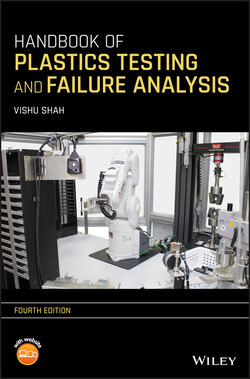Читать книгу Handbook of Plastics Testing and Failure Analysis - Vishu Shah - Страница 15
1 BASIC CONCEPTS AND ADVANCEMENT IN TESTING TECHNOLOGY 1.1. BASIC CONCEPTS
ОглавлениеNot too long ago, the concept of testing was merely an afterthought of the procurement process. Now, however, with the advent of science and technology, the concept of testing is an integral part of research and development, product design, and manufacturing. The question that is often asked is, “why test?” The answer is simple. Times have changed. How we do things today is different. The emphasis is on automation, high production, and cost reduction. There is a growing demand for intricately shaped, high‐tolerance parts. Consumer awareness, a subject ignored by the manufacturers once upon a time, is now a major area of concern. Along with these requirements, our priorities have also changed. When designing a machine or a product, the priority in most cases is safety and health. Manufacturers and suppliers are now required to meet a variety of standards and specifications. Relying merely on experience and quality of workmanship is simply not enough. The following are some of the major reasons for testing:
1 To prove design concepts
2 To provide a basis for reliability
3 Safety
4 Protection against product liability lawsuits
5 Quality control
6 To meet standards and specifications
7 To verify the manufacturing process
8 To evaluate competitors’ products
9 To establish a history for new materials
In the last three decades, just about every manufacturer has turned to plastics to achieve cost reduction, automation, and high yield. The lack of history, along with the explosive growth and diversity of polymeric materials, has forced the plastics industry into placing extra emphasis on testing and on developing a wide variety of testing procedures. Through the painstaking efforts of various standards organizations, material suppliers, and mainly the numerous committees of the ASTM International (ASTM), over 10,000 different test methods have been developed. Globalization has also dramatically influenced test method development, specifically through ISO TC61 on Plastics.
The need to develop standard test methods specifically designed for plastic materials originated for two main reasons. Initially, the properties of plastic materials were determined by duplicating the test methods developed for testing metals and other similar materials. The Izod impact test, for example, was derived from the manual for testing metals. Because of the drastically different nature of plastic materials, the test methods often had to be modified. As a result, a large number of nonstandard tests were written by various parties. As many as eight to ten distinct and separate test methods were written to determine the same property. Such a practice created chaos among developers of the raw materials, suppliers, design engineers, and ultimate end‐users. It became increasingly difficult to keep up with various test methods or to comprehend the real meaning of reported test values. The standardization of test methods acceptable to everyone solved the problem of communication between developers, designers, and end‐users, allowing them to speak a common language when comparing the test data and results. As plastic materials are introduced for use in more rigorous applications, such as structural components in automobiles in the form of high strength composites, the need for test methods that are applicable to these new applications will be important and lead to further development.
In spite of the standardization of various test methods, we still face the problem of comprehension and interpretation of test data by an average person in the plastics industry. This is due to the complex nature of the test procedures and the number of tests and testing organizations. The key to overcoming this problem is to develop a thorough understanding of what the various tests mean and the significance of the result to the application being considered (1). Unfortunately, the plastics industry has placed more emphasis on how and not enough on why, which is more important from the standpoint of comprehension of the test results and understanding the true meaning of the values. The lack of understanding of the real meaning of heat deflection temperature, which is often interpreted as the temperature at which plastic material will sustain static or dynamic load for a long period, is one such classic example of misinterpretation. In the chapters to follow, we concentrate on the significance, interpretation, and limitations of physical property data and test procedures. Finally, a word of caution: it is extremely important to understand that the majority of physical property tests are subject to rather large errors. As a general rule, the error of testing should be considered ±5 percent. Some tests are more precise than others. Such testing errors occur from three major areas: (1) material variation, (2) the basic test itself, (3) the operators conducting the tests, and (4) variations in the test specimens. While evaluating the test data and making decisions based on test data, one must consider the error factor to make certain that a valid difference in the test data exists (2).
